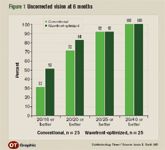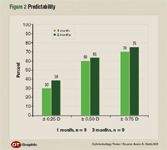Article
Wavefront-optimized technique favored for hyperopic LASIK
Initial findings from a prospective randomized study comparing a conventional ablation (LADAR4000, Alcon Laboratories) and wavefront-optimized technique (Allegretto, WaveLight) for hyperopic LASIK favor the latter for better predictability and vision outcomes. The results are considered excellent for both, however. Initial results from clinical experience with wavefront-guided hyperopic LASIK (CustomCornea, Alcon Laboratories) are also presented.

Key Points
San Diego-Preliminary results from a randomized, prospective, single-center study demonstrate the efficacy and safety of hyperopic LASIK using either a conventional approach performed with an excimer laser (LADAR4000, Alcon Laboratories) or a wavefront-optimized technique with another excimer laser (Allegretto, WaveLight), according to Jason E. Stahl, MD.
Comparisons between the two groups, however, favor the wavefront-optimized ablation for providing better predictability and higher rates of 20/20 and better vision, Dr. Stahl reported at the annual meeting of the American Society of Cataract and Refractive Surgery.

"We were surprised by the superiority of the early vision outcomes with the [wavefront-optimized technique], which appear to be partly attributable to more overcorrection and residual astigmatism in the group that underwent conventional ablation," he said. "Follow-up is continuing to evaluate the stability of the results, and we will also be analyzing topography, wavefront changes, and contrast sensitivity in the two groups."
A study of wavefront-guided hyperopic LASIK (CustomCornea, Alcon) with the LADAR excimer laser is also under way, Dr. Stahl added.
"Perhaps a comparison of that technology with the wavefront-optimized procedure will be the subject of a future randomized trial," he said.
The study comparing conventional and wavefront-optimized hyperopic LASIK randomly assigned a total of 50 patients into the two treatment groups. All flaps were created with a femtosecond laser (IntraLase, Advanced Medical Optics). Although the patients underwent bilateral surgery, because many had presbyopia and had a modified monovision procedure, results were reported only for the dominant eye that was corrected for distance vision with a plano target.

UCVA outcomes continued to improve over time in both groups but remained consistently better after the wavefront-optimized treatment. At 1 month, UCVA was 20/20 or better in 80% of the eyes treated with the wavefront-optimized procedure compared with 58% in the group treated with conventional LASIK; rates of UCVA of 20/16 or better in those study groups were 56% and 35%, respectively.




